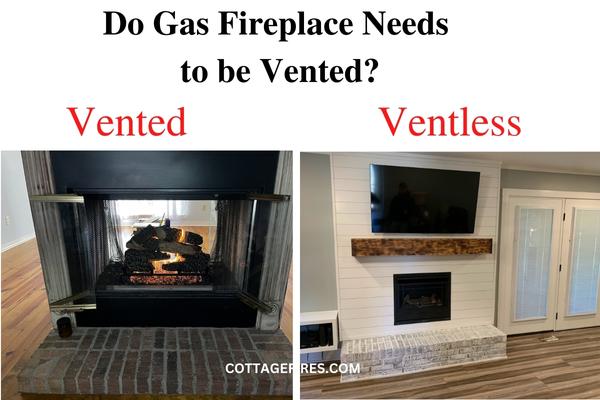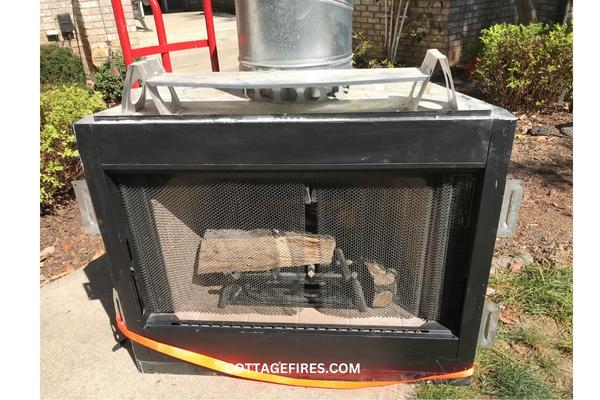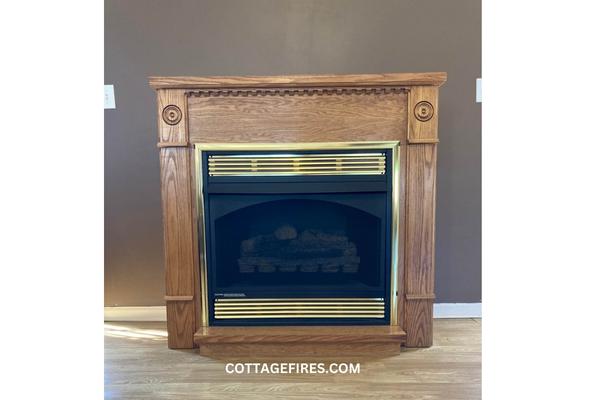Do Gas Fireplace Needs to be Vented? [with Pros & Cons]

It is still becoming increasingly popular to have a gas fireplace. With the flip of a switch, you can light them up and enjoy a cozy, warm fire without the effort and messiness of real logs or smoke and fumes.
However, as there are a few different gas fireplaces to choose from, you might wonder if they all need to be vented.
In short, no, they can be both vented and ventless. Let’s discuss this in more detail so you can decide which.
Types of Vents in Gas Fireplaces
Three types of venting options are available for gas fireplace installations, depending on whether you’re installing it into an existing hearth or a brand-new unit. The following are the categories:
Natural vents, direct vents, and ventless fireplaces.
Natural Vent
Natural vents are also commonly known as “B-vents.” A B-Vent always terminates vertically, which means these products take in combustion air from inside the home and vent it outside the home via a brick-and-mortar chimney or pipe venting system installed through the roof, generally through an existing chimney structure.
B-vent appliances use a single exhaust pipe and draw combustion air inside the room into the combustion chamber, releasing it up through the chimney. They are somewhat identical to traditional wood fireplaces in design, but their venting and burner systems do not allow for wood burning.
A B-vent fireplace, while similar to a wood-burning fireplace, differs in that it is not used as a heat source. Its main function is to provide decor and aesthetics for the home.
Important note: This type of gas fireplace requires proper ventilation. Do not use it if there is any damage to the chimney structure.
Direct Vent
Direct-vent fireplaces are popular and widely used to create a warm and inviting focal point without affecting indoor air quality.
Direct-vent fireplaces are a type of vented gas fireplace that does not use air from inside the home to operate. These products take in combustion air from outside the home and vent it outside the home.
These gas fireplaces radiate heat from the front of the fireplace. They require a dual vent directly through an external wall for venting and exhausting air.
A two-layer pipe is used in a direct-vent gas fireplace to connect the fireplace unit with the home’s exterior directly.
There is virtually no risk of gas or carbon monoxide entering the home, making it eco-friendly and creating a safe environment.
Note: One of the biggest advantages of a direct vent fireplace over a natural vent fireplace is that they can be vented up through the roof or out to the side or back of a house, making them a perfect solution for homes without an existing chimney.

Ventless
As the name implies, ventless products do not use or require venting during installation. They are popular for two reasons: first, they can be installed virtually anywhere in a home, giving the homeowner complete freedom; and second, they produce a significant amount of heat.
Vent-free gas logs don’t need a chimney or flue to function (though they can be installed in a functional fireplace with the damper open or closed). Because of this, most of the heat stays in your home and serves as a great way to heat a space.
They burn the gas fuel so cleanly that they’re rated for internal use with no external venting or exhaust requirements. Although it is recommended that a window remain cracked in the room where the fireplace unit is being used, this replenishes the oxygen in the room that the fireplace uses.
Pros & Cons of Vented Gas Fireplace
Pros:
- Realistic: The best thing about vented gas logs is how appealing and realistic the flame pattern looks, similar to that of a wood fire. Giving the room beautiful and amazing decor.
- Larger flames: When compared to vent-free gas logs, you will notice the flames are much taller in the vented logs than in the vent-free logs, giving them that realistic look.
- No Smell: Keeping the damper open creates no smell, as the smell of the burning logs will go up the chimney rather than into the room.
But there are also some disadvantages to owning a vented fireplace, which is mentioned below.
Cons:
- Heat loss: This is the biggest drawback of having a vented fireplace; they are more for looks as they do not generate much heat and thus cannot be used as a heat source.
- More Gas Usage: Vented gas logs use more gas than ventless logs, thus increasing your gas bill. Some people find this troublesome because they use more gas but do not act as an alternate heat source.
Pros & Cons of Ventless Gas Fireplace
Pros:
- Cost-efficient: As ventless gas fireplaces have no vent or chimney, the installation cost is lower than vented gas products.
- Heat Efficient: A non-vented gas fireplace emits more heat, and all the heat and exhaust it produces stays in the home, making it warm.
While ventless fireplaces do have their pros, they also have a few cons that make them questionable when compared to vented fireplaces.
Cons:
- Smell: Odors can be emitted because of the lack of venting outside of the house as they produce fumes.
- Restrictions: Due to safety concerns, many countries and states restrict or ban the installation of ventless gas systems.
- Mold Growth: The combustion process creates vapor, increasing humidity, and without proper ventilation, the excess moisture leads to mold growth.

Are Ventless Gas Fireplaces Safe?
There has been a buzz regarding whether ventless gas fireplaces are safe. And it is being widely debated, mainly because of their safety concerns.
Ventless gas fireplaces can be used, but it is a standard recommendation not to run your ventless fireplace for long periods and to crack a window for proper ventilation.
Ventless fireplaces also deplete oxygen, so it is best to bring fresh air periodically. New ventless fireplaces come with oxygen monitors to guard against this possibility.
One of the biggest safety concerns is that ventless fireplaces can increase condensation in your home, which leads to mold growth if you do not keep track of it.
Which is Better: Ventless or Vented?
The big question here is which one suits you and whether you’re comfortable with ventless.
Ventless fireplaces are the better heat source of the two options, and because they are less expensive, a ventless fireplace may be the way to go. However, keep in mind that ventless fireplaces emit fumes that are safe for breathing only when the standard recommendations are followed.
And if you are looking for a fireplace to be a cozy and comfortable feature in your living room, a vented fireplace is going to be preferable. It doesn’t burn as cleanly, so the flames look like a wood-burning fireplace.
